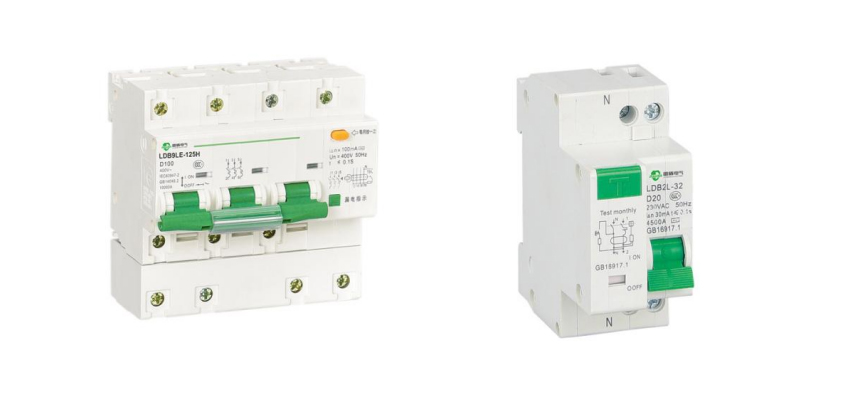The safety of household appliances is becoming more and more important to everyone. In order to ensure the electricity safety, all kinds of devices that can break the circuit have been produced. They include surge protection devices, lightning arresters, Residual Current Devices (RCD or RCCB), over-voltage protectors. But everyone is not clear about what is the difference between these types of protection devices. Now we will tell the difference between surge protector , lightning arresters, current leakage protector, over-voltage protectors. Hope it can be helpful to everyone.
1. The Difference Between Surge Protector and Air Break Switch
(1). Surge Protector
Surge protection device (SPD), also known as “lightning protector” and “lightning arrester”, is to limit the surge generated by strong transient over-voltage in electrical circuits and communication lines so as to protect the equipment. Its working principle is that when there is an instantaneous over-voltage or over-current in the line, the surge protector will turn on and discharge the surge in the line into the ground quickly.
The different protection devices can be classified into two types: power surge protector and signal surge protector.
i. Power surge protector can be a first-level power surge protector, or a second-level power surge protector, or a third-level power surge protector, or a fourth-level power surge protector according to the different capacity of the same capacity.
ii. Signal surge protectors can be classified into categories : network signal surge protectors, video surge protectors, monitoring three-in-one surge protectors, control signal surge protectors, antenna signal surge protectors, etc.
(2) Residual Current Device (RCB)
RCD is also called current leakage switch and Residual Current Circuit Breaker (RCCB). It is mainly used to protect the equipment from leakage faults and personal electric shocks with fatal danger. It has overload and short-circuit protection functions and can be used to protect the circuit or motor from overload and short circuit. It can also be used for infrequent conversion and start of the circuit under normal conditions.
There is another name for the RCD, which is called “Residual Current Circuit Breaker” which detects the residual current. It is mainly divided into three parts: detection element, intermediate amplifying mechanism and actuator.
Detection element - this part is something like a zero sequence current transformer. The main component is an iron ring (coil) wrapped with wires, and the neutral and live wires pass through the coil. It is used to monitor the current. Under normal circumstances, there are a neutral wire and a live wire in the coil. The current direction inside the two wires should be opposite and the current magnitude is the same. Normally the sum of the two vectors is zero. If there is a leakage in the circuit, a part of the current will leak out. If the detection is performed, the sum of the vectors will not be zero. Once it detects that the sum of the vectors is not 0, the detection element will pass this signal to the intermediate link.
Intermediate amplifying mechanism - the intermediate link includes amplifier, comparator and trip unit. Once the leakage signal from the detection element is received, the intermediate link will be amplified and transmitted to the actuator.
Actuating mechanism - this mechanism is composed of an electromagnet and a lever. After the intermediate link amplifies the leakage signal, the electromagnet is energized to generate magnetic force, and the lever is sucked down to complete the tripping action.
(3) Over-voltage Protector
Overvoltage protector is a protective electrical appliance that limits lightning over-voltage and operating overv-oltage. It is mainly used to protect the insulation of electrical equipment such as generators, transformers, vacuum switches, bus bars, motors, etc. from voltage damage.
2. The Difference Between Surge Protector, RCB and Overvoltage Protectors
(1) The Difference Between Surge Protector and RCD
i. RCD is an electrical appliance that can connect and disconnect the main circuit. It has the functions of leakage protection (human body electric shock), overload protection (overload), and short circuit protection (short circuit);
ii. The function of surge protector is to prevent lightning. When there is lightning, it protects the circuits and the electrical equipment. It does not control the line if it assists in the protection.
When there is a short circuit or a leakage or a short circuit to the ground in the circuit (such as when the cable is broken, and the current is too large) , RCD will automatically trip to avoid burning the circuit. When the voltage suddenly increases or lightning strikes, surge protector can protect the circuit to avoid the expansion of the range. Surge protector is sometimes called a lightning arrester in daily life .
(2) The difference Between Surge Protector and Over-voltage Protector
Although they all have an over-voltage protection function, the surge protector protects against the hazards caused by high voltage and high current caused by lightning. The overvoltage protector protects against the hazards caused by lightning or excessive grid voltage. Therefore, the over-voltage and over-current caused by lightning are much more harmful than that caused by the power grid.
RCD controls the current only without control of the voltage. Adding the functions of surge protection and over-voltage protection, a RCD can protect the current and the voltage so that it can avoid the abnormal sudden rise in current and voltage which do harm to human and equipment.
Post time: Sep-17-2021






